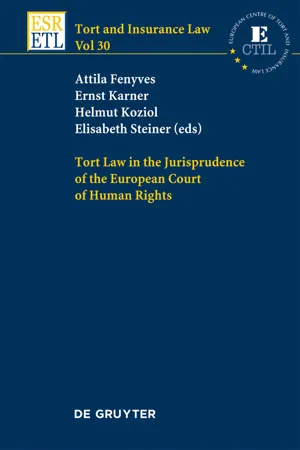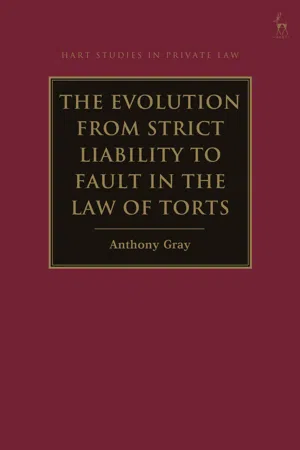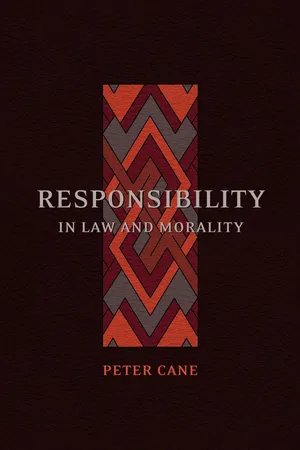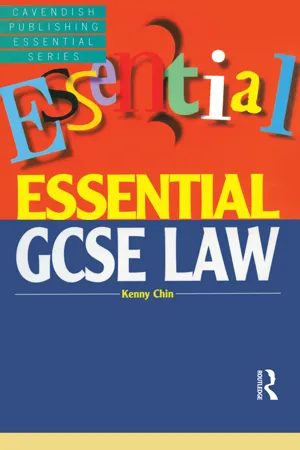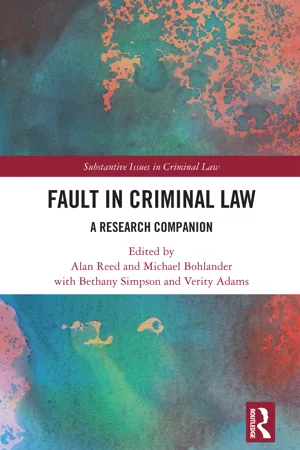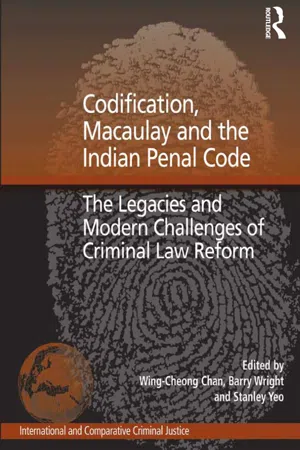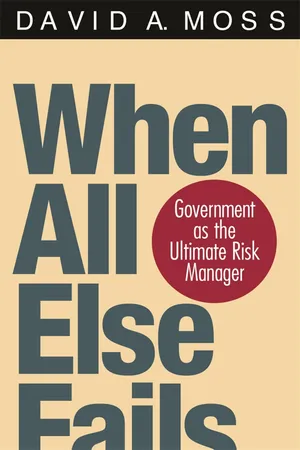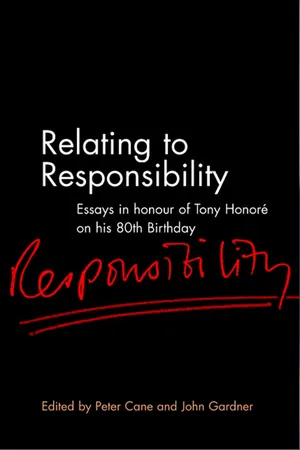Law
Strict Liability
Strict liability refers to the legal responsibility for damages or injuries, regardless of fault or intent. In this context, a person or entity can be held liable for harm caused by their actions, even if they were not negligent or did not intend to cause harm. This principle is often applied in cases involving dangerous activities, defective products, or hazardous materials.
Written by Perlego with AI-assistance
Related key terms
1 of 5
12 Key excerpts on "Strict Liability"
- Attila Fenyves, Ernst Karner, Helmut Koziol, Elisabeth Steiner, Attila Fenyves, Ernst Karner, Helmut Koziol, Elisabeth Steiner(Authors)
- 2011(Publication Date)
- De Gruyter(Publisher)
Subject to this caveat, sample case law will be analysed in order to give a selective glimpse * Dr iur, Austrian Federal Ministry of the Interior. ** Prof Dr, LLM, Civil and Comparative Law Chair, University of Innsbruck, Austria. 1 Law Commission/Scottish Law Commission , Damages under the Human Rights Act 1998 (Law Com No 266/Scot Law Com No 180, 2000) paras 3.4 and 3.5, < http://www.justice.gov.uk/ lawcommission/publications/damages-under-the-human-rights-act.htm > (30.5.2011). 567 into how this jurisprudence may still fit at least in part into traditional tort law concepts. 10/4 The concept of Strict Liability : In tort law doctrine and practice throughout Europe, the term ‘Strict Liability’ stands for a rather broad spectrum of meanings. 2 Its use may therefore lead to misunderstandings which need to be avoided to the extent possible. The bandwidth of potential variations ranges from instances of fault liability where the burden of proving blameworthiness is reversed, without relinquishing the requirement as such, at one extreme to so-called ‘absolute’ liability at the other. 3 Within that range lie liability for risk and the duty to compensate losses arising from lawful interventions, both thus triggered without any illicit behav-iour attributable to the defendant being required. Some even consider vicarious liability to fall within the definition of ‘Strict Liability’ to the extent that personal fault of the employer is not of the essence. 4 10/5 ‘Absolute’ liability mainly requires causation of the loss at issue by the pertinent risk. 5 Whoever is in control of that risk will be held liable irrespective of his behaviour and without any possible defence. Instances of absolute liability are rather scarce, however; the few examples to be found in national legal orders include liability for nuclear installations, which in some countries is not even subject to the force majeure defence.- Anthony Gray(Author)
- 2021(Publication Date)
- Hart Publishing(Publisher)
I take Strict Liability to mean liability imposed in the absence of ‘fault’. When I use the word ‘fault’, I mean a failure to live up to objectively determined standards of conduct. Strict Liability is distinct from absolute liability, 1 and fault could have a range of meanings. 2 I have indicated my intended meaning in this context. Jeremiah Smith Jeremiah Smith’s articles on workers’ compensation statutes were pivotal in the intellectual movement in support of Strict Liability. 3 Smith discussed the introduction of workers’ compensation statutes in the United Kingdom in 1897, providing compensation for workers injured while at work in the absence of any evidence that an employer was at fault in causing the injuries. These statutes were a reaction to the so-called unholy trinity of tort doctrines in the employment context, namely the doctrine of common employment preventing an employee injured at work from obtaining compensation against their employer if they were injured while in the company of another employee, 4 and the strictness with which defences of volenti non fit injuria and contributory negligence applied. 5 These principles crippled the ability of employees injured at work to successfully bring a case against their employer. He noted that, initially, the UK workers’ compensation legislation had applied only to those working in particularly dangerous industries, however within a decade it had been expanded to include all industries. 6 He noted it had been estimated that in nearly half of the cases in which an employee had been injured at work, it was not possible for them to prove that their injuries were the fault of the employer. It was often due to dangers ‘inherent in the method of work and the damaging results may be viewed as inevitable’- eBook - PDF
- Peter Cane(Author)
- 2002(Publication Date)
- Hart Publishing(Publisher)
This fact tends to elicit one of two responses from philoso-phers: either that strict legal liability is inconsistent with ideas of “moral” responsibility and is, for that reason, to be deplored; or that strict legal liability is to be explained in terms of certain “practical concerns” of the law that are not shared by morality. The main purposes of this chapter are to explore the relationship between legal liability and culpability, and to challenge the popular argument that in imposing Strict Liability, the law parts company with morality. In the process, I will also address two major philosophical debates relevant to law: one concern-ing the relationship between responsibility and luck; and the other concerning the relationship between responsibility and the outcomes of conduct. 1 See 1.1 and 2.6. 3.2 RESPONSIBILITY AND LUCK 3.2.1 Limited sensitivity to luck In 1.4.2 it was suggested that for the purposes of analysing responsibility prac-tices, the truth or falsity of causal determinism can be ignored. Even if causal determinism is true, the facts remain that although we feel our conduct to be subject to varying degrees of external and internal limitation and constraint, we experience freedom of choice and a fair degree of control over our conduct and the world around us; that people differ in terms of their capacities and abilities to achieve good outcomes and avoid bad outcomes; that people can change their behaviour patterns; and so on. Regardless of the truth or falsity of deter-minism, we hold ourselves and others responsible, and we accept responsibility, for at least some (of their and our) conduct and some of its consequences. Responsibility is a human construct; and facts about human psychology, and about the way we experience our relationship with the physical world, provide an appropriate basis for analysis and evaluation of our responsibility practices. - eBook - ePub
- Kenny Chin(Author)
- 2014(Publication Date)
- Routledge-Cavendish(Publisher)
Rylands v Fletcher; he need only show that there is a thing acummulated which has escaped and caused damage to him. The House of Lords affirmed this principle in many later cases and added that the use of the land by a defandant has to be non-natural. This excludes the ordinary and reasonable use of one’s own land or the use that benefits the community. Other types of Strict Liability are often duties created by statutes (that is, statutory duties); an example is the statutory duty created by the Consumer Protection Act 1987. The Act provides that, as long as a defective goods supplied to a consumer has caused damage to persons or property, the producer is liable to pay compensation. The claimant does not need to prove fault and the absence of negligence or intention is no defence.DamageNormally, a claimant must have suffered some physical or financial harm. Again, there are exceptions, namely those crimes which are ‘actionable per se’. Actionable per se means actionable by itself. Examples of this are trespass and libel against which a claimant can obtain relief from the courts without having suffered any actual damage.Vicarious liabilityVicarious liability is a concept which is quite unique to tort. This is where one person (including legal entities such as a company) can be liable for a tort committed by another. Examples include a principal being liable for its agent; a car owner for another permitted to drive his car and, most importantly, an employer for his employees.When an employee has committed a tort in the course of his employment, his employer will be liable for those acts which he has authorised to be carried out or for something done incidental to what is authorised. It does not matter whether the authorised act is carried out in a wrongful way. There is no defence, even if the act has been performed in a manner which is expressly forbidden by the employer. In Limpus v London General Omnibus Company - eBook - ePub
Fault in Criminal Law
A Research Companion
- Alan Reed, Michael Bohlander, Alan Reed, Michael Bohlander(Authors)
- 2022(Publication Date)
- Routledge(Publisher)
Note that an interesting point of comparison is provided by the South African criminal justice system. The Constitutional Court of South Africa has determined that it is a foundational tenet of democratic societies that individuals who are not at fault should not be deprived of their liberty. Their disapproval abrogates Strict Liability crimes within South African law, or if they still prevail, ought to be interpreted in such a manner that a fault requirement is read into the statutory legislation. Moreover, as Paizes has contended, all forms of Strict Liability breach the presumption of innocence if they truly involve criminal liability without fault (as opposed to merely requiring lesser), but still potentially culpable standards of liability such as inadvertent recklessness or gross negligence. Paizes contends: ‘Strict Liability constitutes a violation of the right to be presumed innocent which cannot, in my view, be defended in the ordinary course’: see A Paizes, ‘A Closer Look at the Presumption of Innocence in our Constitution: What Is an Accused Presumed to be Innocent of?’ (1998) 11 South African Journal of Criminal Justice 409. Note further that a reverse burden of proof that imposes a full legal burden on the defendant, will generally be regarded as an infringement of the presumption of innocence; and thus unconstitutional.See Bagaric (n 120). It is noteworthy that absolute liability, in general, is rare in Commonwealth jurisdictions, and it has been determined in New Zealand that it should only be applicable if imposed by statutory legislation in clear terms, or by necessary implication; see further Miller v MOT [1986]1 NZLR 660, 668.The position in Australia can be contrasted to that in Canada, where a bespoke and alternate ‘due diligence’ defence has developed at common law.127 This defence is available to offences of ostensibly Strict Liability. It is available either as a separate defence at common law, or as a bifurcated extension of the defence of honest and reasonable mistake of fact. In R v City of Sault Ste Marie,128 - eBook - ePub
Codification, Macaulay and the Indian Penal Code
The Legacies and Modern Challenges of Criminal Law Reform
- Barry Wright, Wing-Cheong Chan(Authors)
- 2016(Publication Date)
- Routledge(Publisher)
Malaya Law Review 1. As will be elaborated below, different common law courts have developed different solutions.Strict Liability
To avoid confusion, it should be clarified at the outset that Strict Liability means different things in different jurisdictions. In England, it refers to liability without fault, which is traditionally interpreted as liability without the need to prove mens rea. In Australia and Canada, courts have developed a midway category between offences which require proof of mens rea and those which do not.40 This middle category, which generally allows for a defence of reasonable mistake of fact (as in Australia) or due diligence (as in Canada), is called Strict Liability. Offences where proof of mens rea is not required and which do not permit the above-mentioned defences are called absolute liability. The preferred use of the term ‘Strict Liability’ is in the Australian/Canadian sense and will be applied here.40 See He Kaw Teh v. The Queen (1985) 157 CLR 523; and The Queen v. City of Sault Ste. Marie [1978] 2 SCR 1299. See further Morgan, Chapter 3 of this volume, above n. 3, at 70.Although Strict Liability offences are generally described as offences not requiring proof of mens rea, the concept of Strict Liability is more nuanced, as pointed out by various academic commentators.41 Some academics in IPC jurisdictions have argued that whatever the position is in the common law, the position under the IPC is clear. If a statute creates an offence without the need to prove mens rea, courts should respect that. The argument is that all such offences would still be governed by Chapter IV of the IPC and the accused would still be entitled to rely on the general exceptions, which include mistake.42 This, however, has not been the case, with the courts importing some of the common law jurisprudence on Strict Liability.4341 D.N. Husak, ‘Varieties of Strict Liability’ (1995) 8 Canadian Journal of Law and Jurisprudence 189; S.P. Green, ‘Six Senses of Strict Liability’ in A.P. Simester (ed.), Appraising Strict Liability (Oxford: Oxford University Press, 2005); P. Cane, Responsibility in Law and Morality - eBook - ePub
Answering for Crime
Responsibility and Liability in the Criminal Law
- R A Duff(Author)
- 2007(Publication Date)
- Hart Publishing(Publisher)
10
Strict Liability and Strict Responsibility
The distinction between offences and defences, I have argued, fits that between responsibility and liability. Offences should be so defined that they identify presumptive wrongs. Proof that the defendant committed the offence charged is then proof that she is criminally responsible for committing a presumptive wrong for which she can be called to answer in the criminal court. Such proof creates a presumption of guilt or liability: the court is entitled to presume that she committed the offence culpably, and is thus liable to conviction and punishment for it. That presumption, however, is defeasible: the defendant can block the transition from responsibility to liability by offering a defence. The prosecution must first prove beyond reasonable doubt that the defendant committed the offence; if it discharges that persuasive burden, the defendant acquires an evidential burden of introducing evidence of a defence.On a familiar, almost orthodox, normative understanding of criminal liability, the offence must include not just an actus reus, but mens rea as to all the essential elements of that actus; only once that is proved is it just to place the burden of introducing evidence of a defence on the defendant. This chapter discusses some ways in which our law does not fit that orthodox model—ways in which it imposes Strict Liability or strict responsibility. I begin, in section 1, by clarifying the orthodox view and its attractions. Section 2 discusses the varieties of Strict Liability and strict responsibility, and the roles of different kinds of presumption. Sections 3 and 4 then move on to the normative task of determining whether any forms of strict criminal responsibility or liability can be justified; we will see that strict criminal responsibility can be justified in some contexts, and that a very limited form of strict criminal liability could be in principle justifiable. As in earlier chapters, however, my concern is with structure more than with substantive content: with the logic of responsibility and liability in the criminal law, and the kinds of argument that would be needed to justify the statutory provisions and doctrines that I discuss, rather than in which of those arguments will ultimately prove to be sound. - eBook - ePub
- Mary Charman, Bobby Vanstone, Liz Sherratt(Authors)
- 2012(Publication Date)
- Willan(Publisher)
mens rea, such as parking and speeding offences, and without Strict Liability guilty people would probably escape conviction. In other cases the consequences are so severe that it is felt that criminal sanctions are required as a matter of social policy, such as selling food unfit for human consumption, or a breach of some of the Health and Safety at Work legislation. In some cases the imposition of Strict Liability operates as a deterrent. The following examples show the practicality of Strict Liability in some situations.- A butcher who buys meat pies from a manufacturer or wholesaler, and sells them to the general public, may be guilty of a Strict Liability offence if those pies are unfit to be eaten, even if the butcher had no knowledge that the pies were contaminated. This may seem to be unfair, but it encourages people to be especially careful in situations where the consequences might have severe results.
- It is a requirement that moving parts of machines should be guarded to protect workers from harm. The employers will be strictly liable under the Health and Safety at Work Act 1974 if they fail to comply with these requirements.
- Under the Trade Descriptions Acts 1968 and 1972 there is a Strict Liability offence of displaying goods with the incorrect price or description.
These are not absolute liability offences, as defences may exist. In the Health and Safety at Work Act, for instance, the duties imposed are only ‘in so far as is reasonably practicable’, which means that an employer could use the defence that to protect the workforce fully would be so expensive as to be prohibitive. The availability of defences means that liability is not absolute, but is strict.The following are examples of absolute liability, where the defendant could offer nothing at all as a defence.Larsonneur (1932)The defendant, an illegal alien, was deported from Eire, and brought to England under police custody. She had no permission to land in England, but was held in a police cell in Holyhead. She was convicted of being an illegal alien ‘found’ within the UK without permission. - eBook - PDF
- Benedict Winiger, Ernst Karner, Ken Oliphant(Authors)
- 2018(Publication Date)
- De Gruyter(Publisher)
In practice mentally disabled persons are generally held liable for their wrongful acts, and the rule is used as a legal authority to reduce the amount of damages. Culpa is not the only basis for liability under Norwegian tort law, which is linked to misconduct. There are also several bases for liability that must be categorised as Strict Liability, both codified and uncodified. 5 There is a general uncodified rule on strict li-ability for dangerous activities or objects if damage is caused by a risk that can be char-acterised as a typical outcome of the existence of the source, and the type of risk in ques-tion would be an ongoing risk as long as the activity or object exists. If the risk has these distinctive characteristics, the event that triggers the potential risk must also – from the group of claimants’ point of view – seemed to have been an extraordinary incident. This kind of liability arose as the result of increasing strictness in the application of the culpa rule during the latter part of the Industrial Revolution. 6 In the reasoning justifying li-ability, some cases have elements of both Strict Liability and liability based on fault. 7 One example of this is an epileptic prisoner who was placed in a cell with an unpro-tected source of heat, which led to him suffering burns to the skin (Rt 1972, 1192). The most practical basis for Strict Liability depending on misconduct is, however, skl § 2-1 regarding employers’ liability, which states: an employer is liable for damage or injury caused intentionally or negligently by an employee during the performance of work or functions for the employer if the conduct was not in accordance with the requirements that the claimant could reasonably expect from the activity or service. - eBook - PDF
When All Else Fails
Government as the Ultimate Risk Manager
- David A. Moss(Author)
- 2004(Publication Date)
- Harvard University Press(Publisher)
As Llewellyn had explained in 1925, the effect of “this legal risk shifting” was that “unheeded real costs [are] forced to the . . . investor’s attention . . . through his pocket.” 60 The notion of enterprise liability was thus inseparable from the logic of accident prevention via cost inter-nalization. Reinforcing their position still further, a number of strict-liability pro-ponents highlighted current research on “accident proneness,” which contradicted the traditional view that fault-based liability would inevita-bly discourage dangerous behavior. In their 1956 treatise on tort law, Product Liability Law 233 Harper and James cited numerous studies suggesting that some people were simply more accident prone than others. The effect of this research, they explained, “has been to cut down the importance of personal moral shortcoming as a factor in causing accidents.” With hardly even a hint of skepticism, Harper and James interpreted the research on accident proneness as constituting yet another nail in the coffin of fault-based lia-bility. Since “the individual may be quite helpless to prevent some of his own accident-producing behavior . . . it would be altogether idle to ex-pect the fear of paying damages to deter it.” A Strict Liability regime, by contrast, would tend “to increase the pressure toward accident preven-tion on large groups and enterprises, where we have seen it will do the most good, rather than on the individual, where it will do relatively little good.” 61 DISTRIBUTING RISK TO ALL CONSUMERS Although the promise of improved accident prevention represented an important rationale for the adoption of Strict Liability in product injury law, it nonetheless appears to have ranked a distant second behind the goal of improved risk distribution in the minds of many proponents. Most of the leading legal scholars who championed Strict Liability de-voted more attention to this latter objective. - eBook - PDF
- Richard Mann, Barry Roberts(Authors)
- 2019(Publication Date)
- Cengage Learning EMEA(Publisher)
173 Chapter 8 Negligence and Strict Liability Harm Burden of Proof plaintiff must prove that defendant’s negligent conduct caused harm to a legally protected interest Harm to Legally Protected Interest courts determine which interests are protected from negligent interference Defenses to Negligence Contributory Negligence failure of a plaintiff to exercise reasonable care for his own protection, which in a few states prevents the plaintiff from recovering anything Comparative Negligence damages are divided between the parties in proportion to their degree of negligence; applies in almost all states Assumption of Risk plaintiff’s express consent to encounter a known danger; some states still apply implied assumption of the risk Strict Liability Activities Giving Rise to Strict Liability Definition of Strict Liability liability for nonintentional and nonnegligent conduct Abnormally Dangerous Activity Strict Liability is imposed for any activity that (1) creates a foreseeable and highly significant risk of harm and (2) is not one of common usage Keeping of Animals Strict Liability is imposed for wild animals and usually for trespassing domestic animals Defenses to Strict Liability Contributory Negligence is not a defense to Strict Liability Comparative Negligence some states apply this doctrine to some Strict Liability cases Assumption of Risk express assumption of risk is a defense to an action based upon Strict Liability; some states apply implied assumption of risk to Strict Liability cases Q UESTIONS 1. A statute that requires railroads to fence their tracks is construed as intended solely to prevent injuries to animals straying onto the right-of-way. B & A Railroad Company fails to fence its tracks. Two of Calvin’s cows wander onto the track. Nellie is hit by a train. Elsie is poisoned by weeds growing beside the track. For which cow(s), if any, is B & A Railroad Company liable to Calvin? Why or why not? 2. - eBook - PDF
Relating to Responsibility
Essays in Honour of Tony Honoré on his 80th Birthday
- Peter Cane, John Gardner, Peter Cane, John Gardner(Authors)
- 2001(Publication Date)
- Hart Publishing(Publisher)
6 OBLIGATIONS AND OUTCOMES IN THE LAW OF TORTS John Gardner * I “Under Strict Liability”, according to Alan Brudner, “one has no right to act in ways that happen to injure another. Since, however, all action carries the risk of such injury, Strict Liability means that I have a right that you be governed in all your actions by concern for my welfare, and you have the same right over me. No doubt there is a mutuality of care here; but it is the mutual care of extreme altruists who, because they claim no worth as independent selves, can neither give nor receive effective confirmation of worth and hence can require no valid right to care. By contrast a fault [i.e. negligence] requirement establishes a reciprocity of care between selves”. 1 Brudner casts his argument in terms of the potential plaintiff’s rights, but (to avoid some distractions further down the line) I am going to reframe it in terms of the potential defendant’s obligations. True enough, P’s rights against D are not the same thing as D’s obligations towards P. A right is not an oblig-ation; rather, it is the ground of (one or more) obligations. 2 All the same, there is nothing that counts as the violation of a right other than a failure to per-form (one or more of ) the obligations that it grounds. Thus the conditions under which D violates P’s rights—the conditions under which D wrongs P— are identical to the conditions under which D fails to perform (one or more of ) his obligations towards P. It follows that, if our interest is in what it takes for D to wrong P, and in the liability to which such wrongs may give rise in * I am grateful to the participants in the Columbia Law School workshop on Tony Honoré’s Responsibility and Fault for a fascinating discussion of my first attempt at the topic, from the ashes of which this rather different paper arose. Special thanks go to my commentator Niki Lacey and to Tony Honoré for giving me the benefit of his first reactions.
Index pages curate the most relevant extracts from our library of academic textbooks. They’ve been created using an in-house natural language model (NLM), each adding context and meaning to key research topics.
